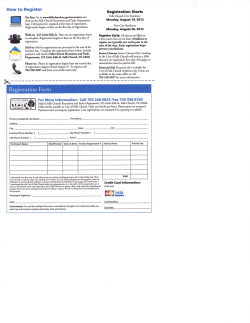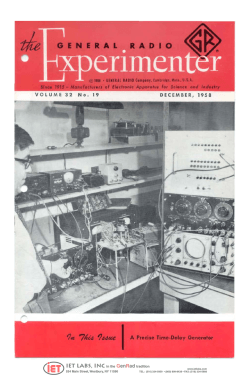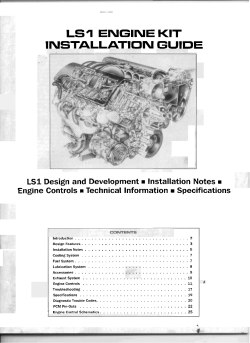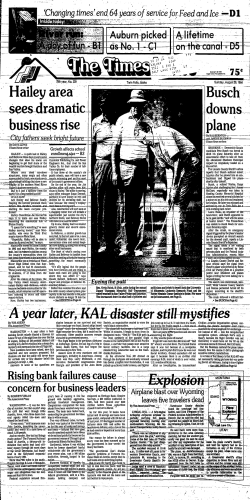
Alan Zinobcr* and Suliadi Sufahani
Pr?:-quk;8 O p ~ n m(701
l 3) X3.7(
)''F;3 71
42013 Brazilian Operabons Research Souely
Pnnted verslon ISSN 0101-74381 Onllk veraon ISSN 1678-5'42
www w ~ c h
brlpopc
A kON-STANDAIW OPTIMAL COKTROL PROBLEM ARISING
IN l$Y ECOKOklICS APPLIC:\rl'IOTI'
Alan Zinobcr* and Suliadi Sufahani
I2rxcir.d Mq 3; 3 1 1 1 :Acc-lytllrl July 1OZ201:
ABSTRACT. A rcccrlt optimal mntrol problcm it1 the arc3 of economics has mathmatical proptrtics that
do not la11 into thc standard optimal control problem formulation. [n our prohlcn~thc slate value at the titla1
time rhe sme, Y ( I - ) = =: is Cree i~ndunknown, and additionally the hgwngian intgrand in the f~tncrio~~ai
1s a p 1 w ~ 7 h consml
. i ~ ~ firncl~minf lhc nnknt~wnvaluc j i1.1. 'I his Ir no1 a sundanl opl~maleoncrol pn~blcni
anti cilnnot ht. solrul u\lng l'oniyagin's Minimum I'nnciplc with the standad h o & q ctmctiiiins at thc
final tlnw. 111 the stanchrtl pnbhlcm r ficc final state j - t f ' ~yield\ a n ~ m x i i qhoundarj condititrn p(7 ) 0,
when ptl) 1s rhc cosmtc. Rccausc the integrand is a function of y~T b , thc fkw ncccrvary condition IS that
r1T) should bc equal to a certain iatgral that is a continuous liuilction of T I . We iniroducc a continuous
approximation of rbe piecewise cunslanl i n t g n ~ i dhalction by using a hyperbolic rangen1 approach and
~ 4 v ijn
e wdniple u s i q a C - ' dlooting dguriQm with Kwtunilrmion for sulvilig 1he'lic.u I'oint b u d ~ r y
Value tbohlcm ( I'i'liVtJ). I'hc ni~n~nii\ing
Tru. valr~cy( I'l is calculal~~l
In :m outcr loop ~lcwlitmusing the
(iulrlcn S L T ~or
I ~ljr~mt
I algurithm I:~)~npuratrvu
11o1dinc;lrprt~granmii~ig
(hP) discrctc-timcrtsults arc r h )
pr~zmtrd
Keywords: optimal ammol, non-standard opiimal cnntn~l,piixiwisc constant ilitcgrand, ~wonomics,u)m-
parativc ~bonlit~car
progm~btningrwults.
Cdculus of Variatio~s(CoV) pnlvidcs thc ~lathcmalieallkcory to solve extrcmixing iuneriotlal
problems f i r ~ l i i c ha given iiinctional has tl smtionary value eitlier nlinirnunl or maxin~um[131.
Optimal control i s an ertensirln nf C:oV and it is a ma~hematicalr)ptirni~atianmcihod Tur deriving
optimal control politics. Optinla1 control c l ~ n n c l thc
s paths of thc control variables to optimiirc
thc ~ 1 s functitmal
t
whilst satisfying (in this paper) ordinary diKe~cntialequations. I:cnnornics is
a sc~urccof intcnsting applications o f Ihc lhcory of C'oV :md clplimal control 1'71. A fnsclassic:d
manlpIt:b tllat m k t the use of optimal control am the drug bust hlrdtegy, topimil pndi~ctiun,
optimal conmd in diwrclc mc~hanics,pllicy arangcmcnl and thc myalty payment pnlhlcm
15.7-91.
*Comspiw~dingaulhor
khtlcll ctr M n ~ k m a d c sand Stidslim, Ilnivmily of Shctlicld. Shcllicid Pi3 7K11. lJnillrl Kin~dtm~.
1:-rnai.1~:;1:r$1t1hr:@<hcllic1d.ac.uk :' appl)Xs&:&~hulticld.~.~~k
64
A NON-STANDARD OPTJMAL CONTROL PROBLEM ARISING IN AN ECONOMICSAPPLICATION
In a recently studied wonomics prohlum a firm struggling will1 inttnsivcly low demand imf their
product will purposely incmsc t hc marginal cost by rcdreing t hc production o r the product and
incrmscthc sclling m c c II 11. I'hcmlimrc the wquircmcnt 10 pay a flat-rate n~yaltyon wlc has the
c f f w ofincm~singthe marginal cost and rhcrcby Qccrcasingthe olitpul whilc simultaneously
incm5ing thc pricc. 'I'hc cr~c?ctof permitling a nonlinear n)yalty I c d s ti) u n o n - s ~ a n d dI'oV
orsolving Lllc
prublcm not previously considcrcd. In this papcr wc will dcmcmstratc somc
p r o h l ~ mwithout discussing thc prccisc c~onomicsdcuils.
Lct us start by considering a simplc problcm. Wc wish to dclcmiinc thc control runc.tion r r ( t )
whcru L ( 10, 7' 1 that maximiws the integral fiunctiowal
N O ) with ~ ' ( 0known
)
and
lc
difknlnlial cqudion $
sllhjcct sdisrying ~ h ~c ~ : ioniinary
thc endpoint state valuc y ( T ) at timc r = T unknown. Tllc Lagran2ian intcgratid dcpcnds on the
unknt~wnlinal ralucy(7') and rhis is nit a skmJard optimal ctmln~lprohlcm bwausc l c lirnaion
dopcnds on ?(TI. A standard optimal control often solves a problem with thc final state ,FIT)
rrw and [hen thc boundary mndition p(T') is ~ c r o1 121. 'l+c iIamiltonian f i ~ opiirnal
r
contrid
thcory arises wllcn using Potitryagin's hiIinimtjn1 Principle (PMP) [13]. It is uscd to find the
optimal a)nln>l Tor taking a dynamicdl system Iixrrn one s ~ t LOc xnothcr a~hjcctto satisrying thc
undcrl ying ordinary dift'crential equations [12]. Wc introduce a continuuus approximation of thc
picucwiw conslant intcgrdnd runction hy using a hypcshc>licLangcnt appnuch. 'I'he prcxanl piper
will indicatc how such problctns can be sol\rcd. In thc acxt section wc wiil discuss thc theoretical
q p n w o h in o d c r t o solve the problem. IVc will fi,llow tho work oTMalinowska mn
id lilm 161,
in proving thc boundary condition for CoV [2]. Then wc will dctnonstratc a numerical cxamplc
and wo will IISL' (: I I Lo solve il. We also cornparu 1hc rc$ulk wilh a nonlinear pn)gramming(NI')
discrctc-time appmqch and then prcscnt somc conclusions.
2 NUN-STANDARD OPTiMAL CONTROL
In classical optimal control problcnls. the function (1) docs not depend specifically on tlic frcc
value -v( 1'). I lowover, in our caw, lhc I agrmgidminirxrdnd runction 1 d~qwndson ~ ( 7 ) . We
prcsent a rcccnt thcorem that indicates that y ( T ) is cqual to a certain intcgnrl at timc T. Malinowska and li~ms161 harc proven rhis hounda~condititm for C:oV on limc scales 121. I'hc
tbllowing t h t w m c m bc applicd to our problem.
'fhcnrcm: 16.71
If j c .) is thc solution of thc following problcm
ksquisa Operacional. Vd. 33(1), 2013
ALAEI ZINOBER and SUUADI SUTAI IAN1
4hcn
fur all 1 E
d
F [ f .,E(/),
dl: P.
10. 1.1. M o ~ ) \ w
j(&),
: ~ ( l j=
) f;:(f.
j(/),
j [ f 1. j(1.))
1;rom an ovlimal wnln)l penpcxtlvconc 1 12. 13 1 ha%thccc~talop ( ? ' )
Hcncc
p(T) = -
I' fi
65
f < { t . ji~).
; ( I ] . y(?'l)-
(r. ~ ( t &r).
) . j t l-l)'/r
(6)
where p(f is the I lamiltt~nianmul~iplimor ciwtale runcticm. Ihctmm 1 shows lhal lhc nCLiC'ssary
optimal condition docs ~iothavc p l T ) = O as is thc case for thc standard classical optimal coritrol
pnlblcm.
Suppose that wc wish Lo considcr a pia..cwisc consrant functiorl f' in (2). For cxamplc, considcr
w hcm :
.vi 7) and
and
?+' =
with r r and
a
h
for
J.
.:0.5:
for 1 > 0.5,-
t~ rcal nuniberr. We have a discontinuous intwgand thal cannot hc difrercntiatcd ax
mluircd in ihc final bour~daycondition (71. WC introduce a conti~luousapproxin~wlionof thc
piwcwisc ujnstanl int~grdndfunclion by using a hyperbolic tangent appwdch in c d e r to have a
continuous smooth li~nc~ion.
Illl~cfappwximaiions haw been lricd but thcy rquircd hundrcds
of terms, fir insmcc in a Fourier strius approximation. 'Ihu tanh(kj) q r c ~ x i m a ~ i oused
n hen:
is vcry accutatc. A numerical cxsmplo will hc prcscntud in thc next swlion.
3 NII%lRKlCAI~EXAM PI,E
'Jhc cxamplc is a sin~plificdvcrsion ofthc propclscd monomics problcms bul has thc samc main
t a t u m . I'he sutt: qualion (Olfl! system) i s dwribed by
We wish lo rnaxirnisc
.//(-)I
=
I'
( { t , y t ~ ]~ .( b ) .:)dl
(10)
i s a contintlous function and T = 10. W{y) is a piecewise constaiit function where
W (J) =
I
I
1.2
for .I. ( 0 . 5 ~
fur 3 =. 0.52
1% :ippmximatc W ( y )using a hypcrbulic tangcni fi~nction
450 say. llilr larger values of 4- wc obtain a smrwthcr
Ici
approximation of tlic filnctiori F t ' ( j ) (scc Fig. 1). Thc known initial statc is y(0) = 0 and final
s m c valuc : y i 7 j is lin.'l'hcrclirrc ~ h Iclamilionian is dcscrihcd by H [ I .J., i l l p )
1 p.lt
ant! w c sclc~1A- s u i ~ b l ylarge.
and
'I'hc wsmc saLislim
The stationarity condition is If,, = 0 and this yiclds
MAN ZINOBER and SUUADl SUrAllANl
--
-
67
Ilquarion (6)holds a)
Wiy)
4
(
!if)
- ( ~ ) ? * { t ) ) ) d f
sin
RESULTS
I here are several necessary conditions that need LU be wtisfid, such the stare equiltiun (9)
and thc costatc quation ( 16) along with lhc stationariiy condition (17). Also thc initial condition
of y(i)) is given and we select ti guessed initial wlue of'p ( O ) . We alw n d to make bure the
boundary condition of ( 18) wH1 bc saiisficd :it the finit1 time. I-, 'This is a two point boundary
e r osed in (1 7) will be qua1 to L'I/')
value prublen~.We need to m b u r e that tlie ite:raliun ~ x l u of
a1 the final time 7'. 'This is satisfied in our algorilhm only whcn tllc p(7') boundary condition
co~iverges. I'hen we will have the optinltll sulution. 'llie rnir~i~~~ising
h e value XI
1')is calculated
in an imtcr loop iteralion using ihc Goldcn Sccrion (or Brcnt) maximising linc search algorithm
We used the I \ . ~ w T Ishouting met1:tlludwith 1 w p u e d values 1:1 = ptO) and v2 = pr i'). We
usc thc programming languagc C i I in urdcr lc) wlvc Lhc shooting nlcthvd and oihcr algorithms
described in the NurnMical Keceipe librdry 181. We itmite the system with the m t e quation
~ ().ct o s ~ a equation
c
p(c), the inlcgral of q!t and Ihc cost function J l t ) .
An optimal solution ivzis u b ~ a i n du i t l ~high accuracy, Tlie msulls are
I:igurcs 2 4 shows ~ h optimal
c
cuwcs o r ihc skdlc? variahlc y(t ), adjoint varjablc
integml ciaIl) and the control variable t i ( ! 1.
Iiigurc 2 - Siare u time shootin$ algorirhm.
/,(I)
and the
-G.B
0
2
6
4
S
1C
5nie
k3"lpre 3 - Castale v time slming algorithm.
3 C5
0
2
a
4
8
1U
tine
Figure 4 Control v tinie shooting algorithm.
11s a ucjmpa~itivc:qpn~ach,wc used a dificmnt lu-mlincarprt~gmmmjng discrcic-time lecbniqur:
to solve lhe .sanle problem [ I , 71. We solved the problem using Euler and also RungeKutta
discrcdwlicln, and an optimi./alion algoriihm in i~rticrt o solve thc unknown u~ntmlvliriablcs u i
at mcll time [ A [ll. We used the AMPI. program language 131 and the MINOS nonlinear solver
with 45 time slcps in o d c r to stilvc ~ h pmblcm.
c
I:igurcu 5 7 show \:hc plot of optimal rcuulb for h o ~ hl c shooting and mnlincar p ~ ~ g r a m m i n g
{SP)appmaclles fbr the state variable y (t 1, cosiate arrd contrl variable ri ( I 1. The wsults are
ewcniidly the umc. 'I'ke NI' rcuuku arc gtwd but the I lamillr~nianuhcn)ting appvach 1s a much
more accurate approach.
In this paper we Iravve sliown ho>w to solrc a non-standard optimal ccmlrol pn>hl~m-Wc hare
p ~ ~ c n l thc
c d ncccssary conditions and Ihc wn~pulationalproccdurcs in order to obtain optimal
so)lulbn~.'lhc ckplirna1solcllitrn ol'a lust pwhlern has h~wnprcswtcd. A shtxliing algi~rithrntogcthcr with a n~wimisingapproach was used to obtain a highly accurdc solution, and con1p:urd
wilh a discrc~c-timenonlinear pn~grdmmingsolution. Our ~cxhniquwcan bc applied 10 the 'ach ~ a lmthcr morc wmplicalcd ccononlics problcnl whcrc thc Lagrangian inrcgrand is pic~czrise
ctbnstani in many s ~ g and
a depends upcm !(I') which is a prk~riunknown.
Pesquisa Operational, Vol. 33(f). 2013
70
A hW3KSTANDARD OPTIMAL CONTROL PROBLEM ARISING IN AN EGOhlOMlCSAPPLlCATlON
Figure 7 Statc v tinw shooting aid NP(x) algorithn~s.
MAN ZINOBER and SULLADISurNiwl
7*
111
RI:TTS JT. 2!Ml. Practical mcthads for uptinrat control using nonlinear, Advances in
I'w~trol,Sccicty fur lndi~slnaland AppIiu1 Maiktmluics (SIAbl), Philadelphia. PA.
121
Fli12HI:I I<A 1tAC & '1.o~
I ~ II)FM.
- s 200X. I lighcr-orticr camlculr~sor varialions on timc . w ~ l aMaihenialical c~ntroldrtory and finance. pp. l4c)-150. Springer, Berlin.
[3]
FoLRlrR R, CAYDM 8c KI.:RN
IC; t l h ~
BW.2002. A W L : a nlodelling language for ma~hcmalical
programming, Duxhry, PmQf3rooksKolc Publishing Comlmny.
141
S I I . I . A ~I;.I 2(K)9. liw~iltaiiai~
q p n ~ a c hto uptinlality coiditiuns in ~wntrol111cury and nousnuwlh anindy~iq.N{~ncmtullhanalyrjc convc)l t h a q w d dl Ecrcn~ialcrliations, I N DAM, liomu.
and
hUp:~~e~~en~.math.t111ipd,i~nac1deO~sit~'deI'a111b~Iil~'stehni.~C
[5]
LEOU.%RI)
D Bi LOKGRV. 1992. Oplimal control ~hcon.and static optimiwlion in xonon~ics,
Cambridge IJt~~vcrstty
Press. C'anlbndgc.
IOJ
M A l . I h o \ k ' s h 4 A tl & 'I ~ K K :,
I I)Phl. 2010. Naturiil h ~ u n h ywnrlitions ill t h ~
calculus of'
w i a i t ~ n s -:%Ia1lii*1?1uitcu/ .WVIJ?IJC/\ H I I ~ C,.fpp/ic,d -%.~C~IIPPS-33f 14): I 7 I 2 I722 Wilcy. do1
10.1OOXmma. 1289.
[7]
PI.:I)ROAFC. TORRlis DIiM & ZlKOl%t-'R
ASI. 2010. A non-ulassical class ofva.arialiona1problcms
with application in economics. ~~r~c.~-nuiioncti
Jcntrnul (I/' :-/rrilicrtturicrrl 2$fr.lr,d~*IIirtg
UIIJ:Viint~>,-ir.u!
Oj."ir~zivt:lriiorr, 113): 227 230. Lncl~rSdcncc.tltji: 10.1 5W.4.I MMNO.20 10.031750.
181
I'KI SS WII.'II (JKOJ S K Y sn. Vt 1 l l HI lhr; w I.& k l A h V l KY
2007. N ~ ~ r n c r i c a l r w i ~ . ' l h c
ai%ol-giaitific conlpuring. lXrc1 edition. Cambridge Lnir. Prehd. Cambrid-ge.
[9]
SI.:TIIISP & TIIOMPSON
GL.3000. Oplimal control theory Applicalions on nlanagctliet# scicncc
and wonomics. SLxond edition. Kluwcr rycad~micPublislwrs; ikston, Mi\.
4 10]
V I N 1-1 I( H. 2000. Systcrn and ccmtrol: fuu~~dation
and application oplinull control. 1Erkhu I3aslu11.
Springer-Vcrlag KL% York, NcW Yt~clrk.
1 1 1 1 .ZINLIIIIII~nsl
KAIVA'V'III K.
20nX. Opliimal prr~ducliansuhjiwl tc) pi~y:cwi.wmndnoous n~yally
payment obligations, in~enlalrepun.
11.31 PIN(-11
I'K. 1993. Optimal control and Ihc calculus orvarialions. Ilxliml Ilni~cmityf'ms. 0sfi)rd.
© Copyright 2026













